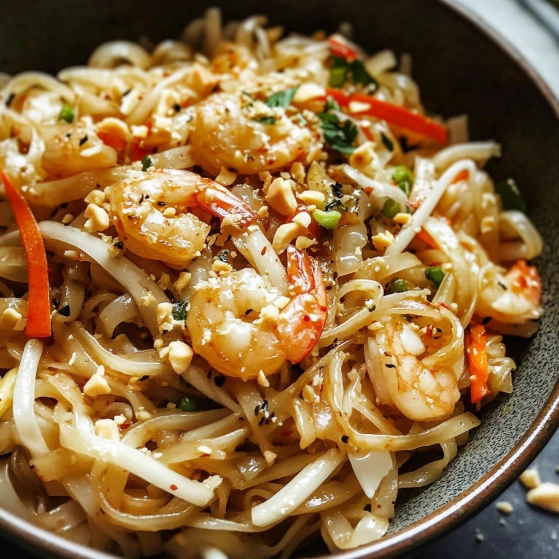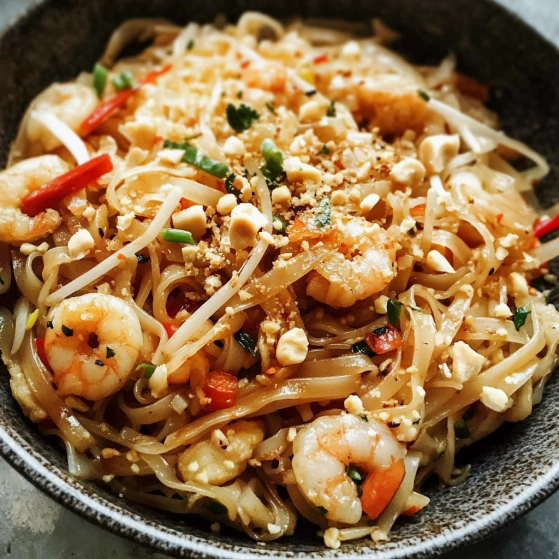 Pin it
Pin it
This homemade Pad Thai brings authentic Thai street food flavors right to your dinner table with the perfect balance of sweet, salty, and tangy notes. The vibrant noodle dish comes together quickly and always satisfies my craving for something exotic yet comforting.
I discovered this recipe during my culinary adventures trying to recreate my favorite restaurant dishes. After several attempts perfecting the sauce balance, this version has become my go-to crowd pleaser whenever I entertain friends who appreciate global cuisine.
Ingredients
- Rice noodles: Form the foundation of this dish providing an authentic texture that soaks up the flavorful sauce beautifully
- Fish sauce: Delivers that unmistakable umami depth essential for authentic Thai flavor
- Brown sugar: Balances the saltiness with just the right amount of sweetness
- Rice vinegar or tamarind paste: Provides the characteristic tang that makes Pad Thai distinctive
- Fresh bean sprouts: Add essential crunch and lightness to balance the rich sauce
- Crushed peanuts: Contribute texture and nutty flavor that defines classic Pad Thai
- Fresh lime wedges: Brighten everything with a squeeze of acidity right before eating
- Sriracha hot sauce: Allows you to customize the heat level according to your preference
Step-by-Step Instructions
- Noodle Preparation:
- Cook the rice noodles according to package instructions just until tender being careful not to overcook them since they will continue softening when added to the wok. Immediately rinse under cold water to stop the cooking process and prevent sticking.
- Sauce Creation:
- Combine all sauce ingredients in a bowl whisking until the brown sugar dissolves completely and the peanut butter integrates smoothly. This balanced mixture delivers the signature tangy sweet savory profile that makes Pad Thai irresistible.
- Protein Cooking:
- Heat oil in a wok over medium high heat until it shimmers then add your protein of choice along with garlic and bell pepper. For shrimp cook just until they turn pink about one minute per side. Chicken requires a bit longer around 3 to 4 minutes total until just cooked through with no pink remaining.
- Egg Addition:
- Push the cooked ingredients to one side of the wok and add a touch more oil to the empty space. Pour in beaten eggs and let them set slightly before scrambling them into small pieces. This creates distinct bits of egg throughout the dish rather than coating the noodles.
- Final Combination:
- Add the prepared noodles sauce bean sprouts and most of the peanuts to the wok. Use tongs or two large spoons to toss everything together ensuring the noodles are evenly coated with the sauce. The heat should be maintained to help the sauce thicken slightly and cling to the noodles.
- Garnishing:
- Transfer to serving plates and top with green onions remaining peanuts fresh cilantro and lime wedges arranged attractively around the dish. The finishing touches add bright flavor pops and visual appeal.
 Pin it
Pin it
The secret ingredient that transformed my Pad Thai was actually the peanut butter in the sauce. While not strictly traditional it adds a creamy richness that creates a more luxurious sauce that clings beautifully to the noodles. My Thai neighbor initially raised an eyebrow but after tasting it she admitted it was a clever adaptation.
Protein Options
While shrimp is perhaps the most popular protein choice for Pad Thai chicken provides a more economical alternative that soaks up the flavors wonderfully. For vegetarians extra firm tofu works beautifully when pressed to remove excess moisture then cut into small cubes. For the best texture with tofu consider tossing it in a tablespoon of cornstarch before frying to create a slight crispy exterior that holds up when mixed with the sauce.
Make Ahead Tips
Pad Thai is best enjoyed fresh but you can prepare components ahead to streamline cooking. The sauce can be mixed and refrigerated up to three days in advance. You can also chop all vegetables and protein the morning before cooking. The rice noodles should only be soaked right before cooking as they become sticky and may break when stored. If absolutely necessary assemble the entire dish but reserve the garnishes and a splash of fresh sauce to revive leftovers when reheating.
Authentic Variations
Traditional Pad Thai in Thailand often includes dried shrimp and preserved radish which add complex umami notes. If you have access to an Asian market consider adding a tablespoon of minced preserved radish and a tablespoon of small dried shrimp to enhance authenticity. Some regions also add a touch of palm sugar instead of brown sugar for a more complex caramel flavor. The dish evolved during World War II when rice noodles became a popular substitute for scarce rice making Pad Thai a relatively modern but now iconic dish in Thai cuisine.
 Pin it
Pin it
Frequently Asked Questions
- → What's the best protein to use for Pad Thai?
Pad Thai works wonderfully with shrimp, chicken, or extra-firm tofu. Shrimp adds a delicate seafood flavor and cooks quickly (1-2 minutes per side), chicken provides a heartier texture (3-4 minutes cooking time), while tofu offers a great vegetarian option that absorbs the sauce beautifully. You can even use a combination of proteins for variety. Just ensure all proteins are cut into small, bite-sized pieces for even cooking.
- → Can I make Pad Thai without fish sauce?
Yes, you can substitute fish sauce with a vegetarian alternative. Mix equal parts soy sauce with a splash of lime juice and a pinch of brown sugar to mimic the umami and tangy notes. Another option is using vegetarian 'fish sauce' made from seaweed or mushrooms, available in many Asian markets. While the flavor profile will be slightly different, these substitutions still create a delicious dish.
- → Why did my noodles turn out mushy?
The most common reason for mushy noodles is overcooking. Rice noodles should be cooked just until tender but still slightly firm (al dente). Cook them according to package instructions, then immediately rinse under cold water to stop the cooking process. Another tip is to slightly undercook the noodles since they'll continue cooking when added to the hot wok with the sauce.
- → What's the difference between using rice vinegar and tamarind paste?
Tamarind paste provides the traditional sour note in authentic Pad Thai, with a complex fruity tartness that's distinctive to Southeast Asian cooking. Rice vinegar offers a cleaner, milder acidity that's more accessible for home cooks. While tamarind paste creates a more authentic flavor profile, rice vinegar makes an excellent substitute that still produces a delicious result. If using tamarind paste, you may need to adjust the sweetness as tamarind can be quite sour.
- → How can I adjust the spice level in Pad Thai?
The spice level in Pad Thai comes primarily from Sriracha hot sauce in this recipe. For a milder version, reduce the amount to 1 teaspoon or omit it entirely. For those who enjoy heat, increase to 2-3 tablespoons or add fresh chopped Thai chilies during the stir-fry process. You can also serve chili flakes or Sriracha on the side, allowing each person to customize their spice level.
- → Why is my Pad Thai dry/soggy?
Dry Pad Thai usually results from insufficient sauce or noodles that absorbed too much moisture. Add a splash more sauce or a tablespoon of water if it seems dry during final tossing. Conversely, soggy Pad Thai typically happens when noodles are overcooked or when there's too much sauce. Make sure to rinse cooked noodles with cold water to stop cooking and drain them well before adding to the wok. Always toss ingredients quickly over high heat to help evaporate excess moisture.
